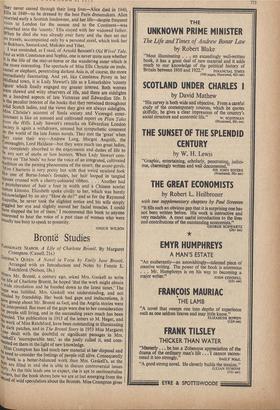Two Ladies
ALICELLA. By Averil Stewart. (John Murray, 21s.) IT is always pleasant to see the conventional views of family relationships defied. Mrs. Stewart has done this by writing an affectionate and delightful life of her mother-in-law, Lady Stovar (Alice), and her mother-in-law's sister, Miss Christie (Ella). Stewart's book, however, is a good deal more than a rare offerl of a daughter-in-law's piety, it is a most informative piece '30 social history excellently assembled by someone with more the an amateur sense of the past. The Misses Christie were born in the Sixties of a comfortal7lei cultured Scottish gentry family. They were, however, a good de en more, for since they had no brother, their father gave then"' 3 t education far beyond that of the young lady of the day---e°d forgetting the Grand Tour. They were well read, accomPlishhe.y linguists, good conversationalists, gourmets and 'collectors.' had also the accomplishments of their sex and class—they Werd excellent hostesses, managed large households and organised g°;, works on a big scale. On top of this, although somewhat plat
they never ceased through their long lives—Alice died in 1940, Ella in 1949—to be dressed by the best Paris dressmakers. Alice married early a Scottish landowner, and her life—despite frequent visits to London for the season and to the Continent—was absorbed into the 'county.' Ella stayed with her widowed father. When he died she was already over forty and she then set out on travels, accompanied only by a personal maid, which took her to Bokhara, Samarkand, Mukden and Tibet.
I was reminded, as I read, of Arnold Bennett's Old Wives' Tale. lust as with Constance and Sophia, one is never quite sure whether It is the life of the stay-at-home or the wandering sister which is the more interesting. The spectacle of Miss Ella Christie on mule, Fame( or elephant, penetrating darkest Asia is, of course, the more Immediately fascinating. And yet, like Constance Povey in her Midland town, it is Lady Stewart's life as a Lanarkshire 'county Figure' which finally engaged my greater interest. Both women were shrewd and witty observers of life, and there are sidelights on a hundred aspects of late Victorian and Edwardian life. It Is the peculiar interest of the books that they remained throughout solid Scotch ladies, and the views they give are always sidelights. Miss Christie's account of Simla society and Viceregal enter- tainment is like an amused and cultivated report on Plain Tales from the Hills. Lady Stewart's remarks on Edwardian London society is again a withdrawn, amused but sympathetic comment On the world of the late James novels. They met the 'great' when they came their way—Andrew Lang, Margot Asquith, the Connaughts, Lord Haldane—but they were much too great ladies, (no completely absorbed in the enjoyments and duties of life to be.e, any sort of snobs or lion hunters. When Lady Stewart corn- Monts on 'The Souls' we hear the voice of an integrated, cultivated tradition on the passing phenomena of the smart, the avant-garde. Miss Charteris is very pretty but with that weird strained look like one of Burne-Jones's females, her hair looped in tangled Masses crossed with a cherry-coloured ribbon. . . . Another had 4 protiiberance of hair a foot in width and a Chinese scarlet cotton kimono. Elizabeth spoke civilly to her, which was barely deknowledged by an airy "How de do?" and as for the Raymond Asquiths, he never took the slightest notice and his wife simply ,Roggled her eye and slightly moved her facial muscles. I could have slapped the lot of them.' I recommend this book to anyone Interested to hear the voice of a past class of women who were usually too busy to speak to posterity.
ANGUS WILSON



































 Previous page
Previous page